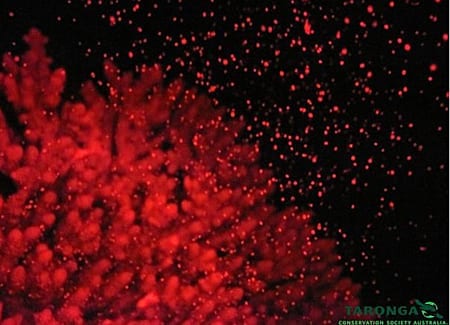By Daniel de la Calle

As advanced celebration of Saint Nicholas the Wonderworker tomorrow, here are a few links, photos, videos and news for you all, stuffed inside the shoes you are putting out tonight:
•A team of scientists at Santa Cruz’s University of California have spent the past three years studying the submarine springs at Puerto Morelos, Mexico. The springs offer a preview of sorts of the fate of coral reef ecosystems in a less basic (damaged by Ocean Acidification) marine environment. The submarine springs, known as “ojos”, are common along the eastern coast of the Yucatán Peninsula. For thousands of years limestone “karst” landforms near the coast have featured underground drainage systems that discharge brackish water at the ojos. The discharged water has lower pH than the surrounding seawater. Professor Adina Paytan and the rest of the team monitored ten of those “eyes” (ojos) and conducted ecological surveys around each site. “This study has some good news and some bad news for corals,” said Paytan, coauthor of a paper published last november in the journal Coral Reefs, “the good news is that some species of corals are able to calcify and grow at very low pH. The bad news is that these are not the ones that build the framework of the coral reefs. So if this is an indication of what will happen with future ocean acidification, the reefs will not be as we know them today.”
Read more HERE.

Download THIS extremely informative PDF.
•Following up on such efforts as the World Seed Bank, Australia’s Taronga Western Plains Zoo has started developing a “frozen zoo”, a bank of genetic material from endangered species. Some frozen sperm and IVF embryonic cells from two coral species present in the Great Barrier Reef were flown this past November to the New South Wales zoo. The vials, stored now in liquid nitrogen, contain enough material to produce more than a million new corals even hundreds of years from now. Those new corals could be used in some future re-population or to increase the genetic diversity of particular reefs. The work was carried out by the zoo’s manager of research and conservation programs, Dr Rebecca Spindler, and by Dr Mary Hagedorn, a world expert in coral IVF at the Smithsonian Institution. They worked with two common staghorn species (Acropora millepora and Acropora tenuis), but Dr Hagedorn understands they now “need to sit with Australian coral scientists and ask which are the most important species for Australia [to store]”. Read more on THIS Sydney Morning Herald piece.

Photo by Rebecca Spindler
•Northwest oyster die-offs made the news in newspapers, television and the internet last month. THIS is a good piece by Elizabeth Grossman for Yale Environment 360 on the hatcheries and the problems this $73 million a year industry has had to endure since 2006. The particular water conditions of this region, in which colder, more acidic waters surge from the bottom of the ocean, has already made it very difficult, at times impossible, for oyster larvae to grow. The article has interesting quotes by NOAA’s Dick Feely, George Waldbusser from Oregon State University and Benoit Eudeline, chief scientist at the Taylor Shellfish Hatchery.
•Virginia’s oyster industry is taking very seriously the news about Pacific Northwest farms being affected by Ocean Acidification and is trying to take proactive monitoring measures and lessons learned in other areas for the more-than-probable future. Although cases of damage from acidification have only been noticed in Maine, the Atlantic coast could begin to suffer from the same oyster larvae hatching problems seen West. READ MORE HERE.
•A large ceramic coral reef is awaiting those who visit the American Association for the Advancement of Science in Washington. The 10 by 15 feet piece was created by artist Courtney Mattison with the title “Our Changing Seas: A Coral Reef Story”. In the words of Ms. Mattison it “combines marine conservation science and policy, fine art and social sciences”. The large mural work is part of a group exhibition called “Beneath the Surface: Rediscovering a World Worth Conserving”.
More info from the NOAA Coral Reef Conservation Program HERE.
•Scientists at UCSB’s Marine Science Institute recently confirmed the critical role algae-clearing fish have in coral growth and recovery. At Moorea Coral Reef in French Polynesia the researchers discovered that the region’s herbivorous fish clear the way for coral growth by eating algae from around the reef.
A combination of a series of cyclones and the raise in numbers of crown-of-thornes sea stars had brought the previous 40-45% outer reef coral coverage (which is significantly high) to almost zero, but the corals are beginning to make a comeback. Although algae usually take over a cleared area, fish prevented them from reaching a level of coverage that kept baby corals from growing. MSI scientists believe more effort should be put in the future into preserving fringe reefs, where algae-consuming fish grow up, in order to have a healthy population of adult fish in the future.
More info HERE.
•A year or two ago we already wrote about this: Mussel shells are perfect recoding devices into which scientists can examine water acidity and other significant data. Dr. Cathy Pfister from the University of Chicago and her colleagues have been taking samples from 1,000 year old middens from the Makah Nation in Washington State, comparing them with shells from the 1970s and 2000s and measured the changes.

The conclusion is that they are even greater than would be expected from the process of Ocean Acidification, local upwelling or the changes in nitrate and phosphate.
You can download a copy of the recently published PLoS ONE manuscript HERE.
A VIDEO from the Seadoc Society with Cathy Pfister HERE.
•The University of New Hampshire will benefit from the more than $1.7 million federal funding recently awarded by NOAA to NEARCOOS, the Northeastern Regional Association of Coastal Ocean Observing Systems. The money will go to the University of Maine, the Gulf of Maine Research Institute, the Universities of Maine, Massachusetts, Rhode Island and Connecticut and the Bedford Institute of Oceanography, in Nova Scotia as well. The University of New Hampshire plans to use these moneys to support a wave buoy implemented with instruments to continue measuring Ocean Acidification at Great Bay.
Read more HERE.


